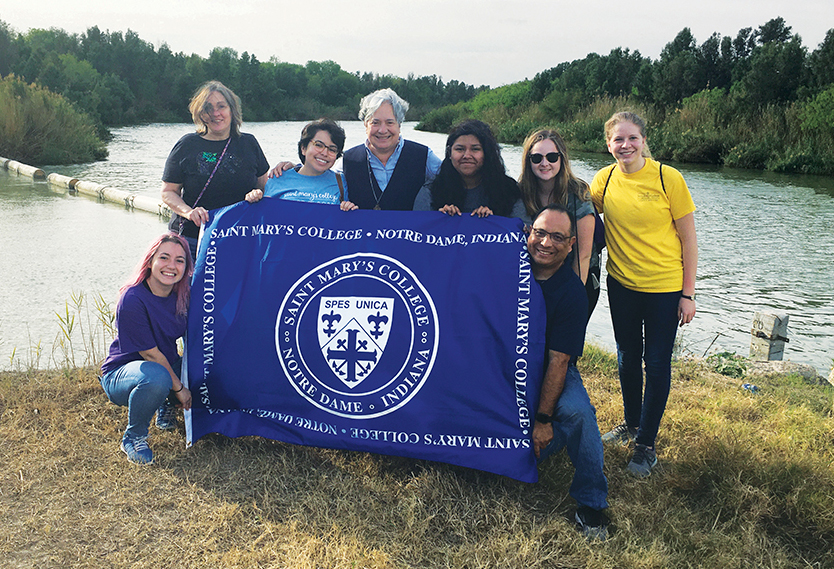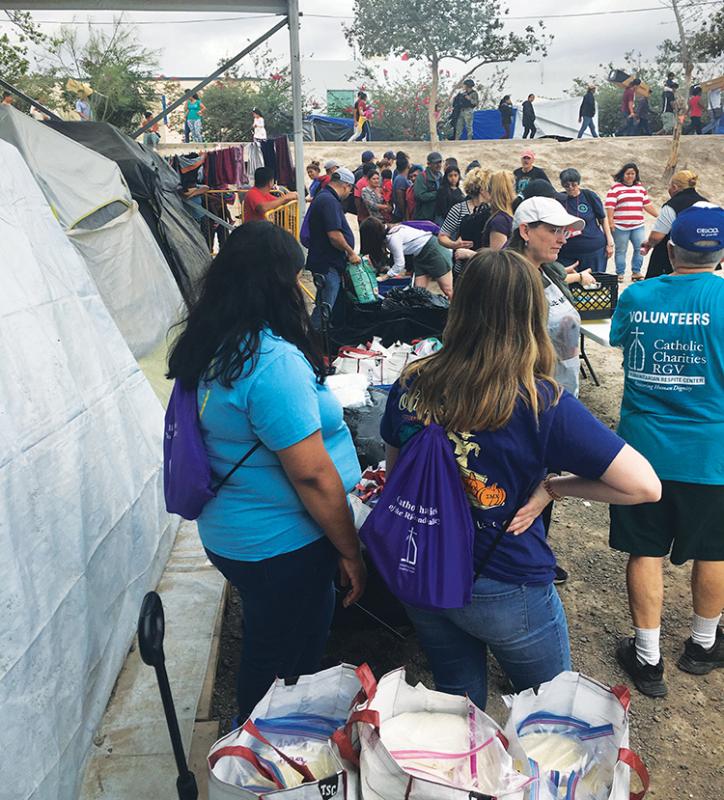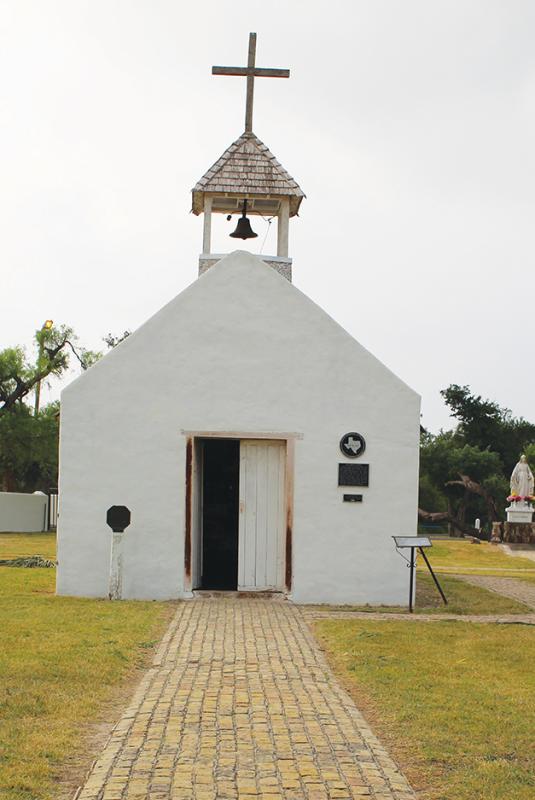Expanding Our Worldviews - My Experience at the Border
Editor’s Note: As part of her global studies experience at Saint Mary’s, Margaret Cicchiello ’22 traveled to the US/Mexico border as part of a spring break cultural immersion trip organized by SMC faculty members Leonard Sanchez and Kathyrn Lyndes. Here she shares a reflection of her time there, and the impact it has had on her life.
The sidewalks of Brownsville, Texas, were crowded as a group of students pulled wagons full of blankets, toiletries, and cooking ingredients toward the border checkpoint into Matamoros, Mexico. Once through, the sidewalk suddenly gave way to rocky dirt. They didn’t stop to buy candy from the children who ran up to them, because they had used their change to pay the border toll. Tents—dozens of them in every direction—made it clear they had reached their destination. This ‘tent city’ was flanked by a fence on one side and a river on the other; laundry strung along its bank. Residents used water to turn the dusty dirt into clay to make simple ovens. It was here where the students delivered their wagons, full of ingredients like salt, cooking oil, and flour to the 2,000 people who were living there indefinitely, waiting for information about their asylum status.

Rebecca Klaybor ’21, Professor Kathryn Lyndes,
Reina Galvan ’22, Sister Norma Pimentel,
Magdalena Hernandez ’20, Marie Burke ’20,
Professor Leonard Sanchez, and Margaret Cicchiello ’22
make a stop at the Rio Grande.
On spring break in 2020, I joined four Saint Mary’s students and two professors in McAllen, Texas to assist the men, women, and children waiting at the borders. This week-long experience was facilitated by Leonard Sanchez, professor of social work, and Kathryn Lyndes, assistant professor of social work and gerontology. It was important to both of them that students from Saint Mary’s were able to meet personally with people who are directly impacted by this humanitarian crisis, so we could better understand the situation. In partnership with Respite Center Ministries (RCM) and Sister Norma Pimentel, MJ, executive director of Catholic Charities of the Rio Grande Valley, our small group joined RCM to offer aid throughout McAllen and in Brownsville, about an hour’s drive away.
According to Sanchez, the idea for this trip started when Rev. Joe Corpora, CSC, a priest at the University of Notre Dame, asked Sanchez if he knew of a social work student who could complete her practicum with Sister Norma. Father Corpora had known Sanchez for a long time; he had been his pastor in Goodyear, Ariz. where he had worked with Sanchez’s mother. “In 2019 I went on a site visit to Catholic Charities of the Rio Grande Valley to meet with Sister Norma’s staff. I knew soon after I arrived that I wanted to organize more than a practicum experience,” Sanchez said. “I felt a strong need to start the border immersion program so that students have their senses filled with sights and sounds of what a modern miracle looks like in the year 2020. Sister Norma has moved mountains to help masses of humanity in search of a better life, and God.”
He continued, “I wanted groups of students from Saint Mary’s College to learn about the journeys of the countless number of refugees seeking political asylum on the US/Mexico border.”
Lyndes agreed, joining forces with Sanchez. “Part of Saint Mary’s mission is to promote a life of social responsibility, that we are called to build awareness for our troubled world and social injustice, and to respond to it with compassion.”

Marie Burke ’20 (r) join Professor Kathryn Lyndes
(white hat) in handing out supplies with the other
Respite Center volunteers in the tent city just
across the border in Matamoros, Mexico.
We learned from the people we met at the border. Each individual and family was trying to reach US soil to be granted asylum. I remember being impressed by everyone there, how innovative they were, how calm they were under the circumstances. There were volunteers from multiple organizations working with the people living in the tent city; some were singing songs with a group of children, a group had provided portable charging stations, and stylists were giving haircuts. While it felt good to see volunteers there providing comfort, I knew that we needed to be doing more. The basic needs of the asylum seekers were not being met. With so many in such a small area, there were not sufficient showers, toilets, or security, and it was unclear if they had safe drinking water.
Sanchez recalls spending his first visit preparing meals and driving people to the bus station. Because of the volume of people seeking refuge through RCM, some days were entirely spent making sandwiches. When we arrived in March 2020, most of those seeking asylum were unable to stay in the United States with their sponsors while they waited. As a result, the tent city on the Mexican side of the border was created as a temporary waiting location, established by humanitarian aid centers, like RCM. But asylum seekers frequently wait an indefinite time for news on their asylum status. Many wait years. So, instead of providing fresh clothes and food at the respite center, as Sanchez intended for us, we spent our time packaging ingredients and other toiletries, loading them into wagons, and walking them across the border. There clearly would not be enough for the thousands there. But still, we delivered the supplies.
On one delivery day, children asked us for milk. It was frustrating and disappointing that we didn’t have any to offer them. Later, as we processed what we were seeing and hearing, one in our group remarked how calm, and even hopeful, people seemed, even without milk or toothpaste or countless other provisions. Student volunteer Magdalena Hernandez ’20 reflected that the asylum seekers were survivors who often fled unsafe, even life-threatening environments in their home countries, and said “Their resilience and motivation to find a better life held them together” while they were waiting for asylum in less than ideal conditions.
On our trip, we spent time learning from Sister Norma. Her commitment to helping asylum seekers lies in her Catholic faith. “We believe in a God of love, a God who tells us we must welcome the stranger, feed the hungry, clothe the naked,” she said. She and her staff arranged for our group to help at other nonprofits and visit area sites.
One day we visited La Lomita Chapel, a one-room chapel built 150 years ago as a meeting place for the Cavalry of Christ.

Chapel in Mission, Texas. A historical landmark, La Lomita
was built in 1865 and served as a church for local ranchers
as well as a place of rest for generations of travelling
missionaries, like the Cavalry of Christ.
The chapel is a historical landmark and serves as a physical reminder of hope for all who encounter it on their way to the border. Learning that the chapel had been a place for Masses, baptisms, weddings, and funerals for all of that time was poignant. However, when I learned that the diocese was fighting to keep the chapel from being torn down to make room for the border wall, I was overcome by the strength and determination that was the legacy of those who had built the chapel and those who had been taking care of it since.
At Saint Mary’s, we are taught to value life and help each other. This was motivating for our work. But the lack of resources for the asylum seekers adding to their dangerous journeys was frustrating. Although we were awed by the strength of the people we met, it was easy to feel that the work would not make a significant difference for this enormous problem. I’m glad we were able to provide help for a few days, but most of the support at the border is being provided by volunteers who were there before we arrived and would be there after we left. After we got back and I had time to reflect on the people we had met, I realized that this trip had been for us. Like with so many other cases “it is in giving that we receive.” Our intention may have been to provide support for people who do not have sufficient resources, but we were the ones who gained something important. The lasting change was within myself—the faces I now put with the facts I know about this humanitarian crisis, and the increasing motivation I have to help people understand the situation.
Because of the COVID-19 pandemic, there has not been another McAllen immersion trip since 2020, although Sanchez is committed to continuing it. “My vision for the McAllen border immersion is that the College creates a community on campus to support future trips,” Sanchez said. “So we can continue learning about the precious life of an asylum seeker.” In addition to students receiving course credit, as the first group did, a longer internship with RCM may be a possibility in the future, he said.
The Saint Mary’s community is made up of people who are invested in social justice and human dignity. Our community understands that in order to avoid dynamics like white saviorism, it is important to acknowledge what we don’t know about new situations, and be open to learning. After meeting people who are personally affected by life-threatening situations in their countries, and who are trying to build new lives here, I understand more about asylum seekers than I did before.
My own commitment to social justice deepened while at Saint Mary’s. And by reflecting on the bravery and patience of those who are crossing our border to work and learn here, I am emboldened to do as much as I can to help. How can I do any less?
